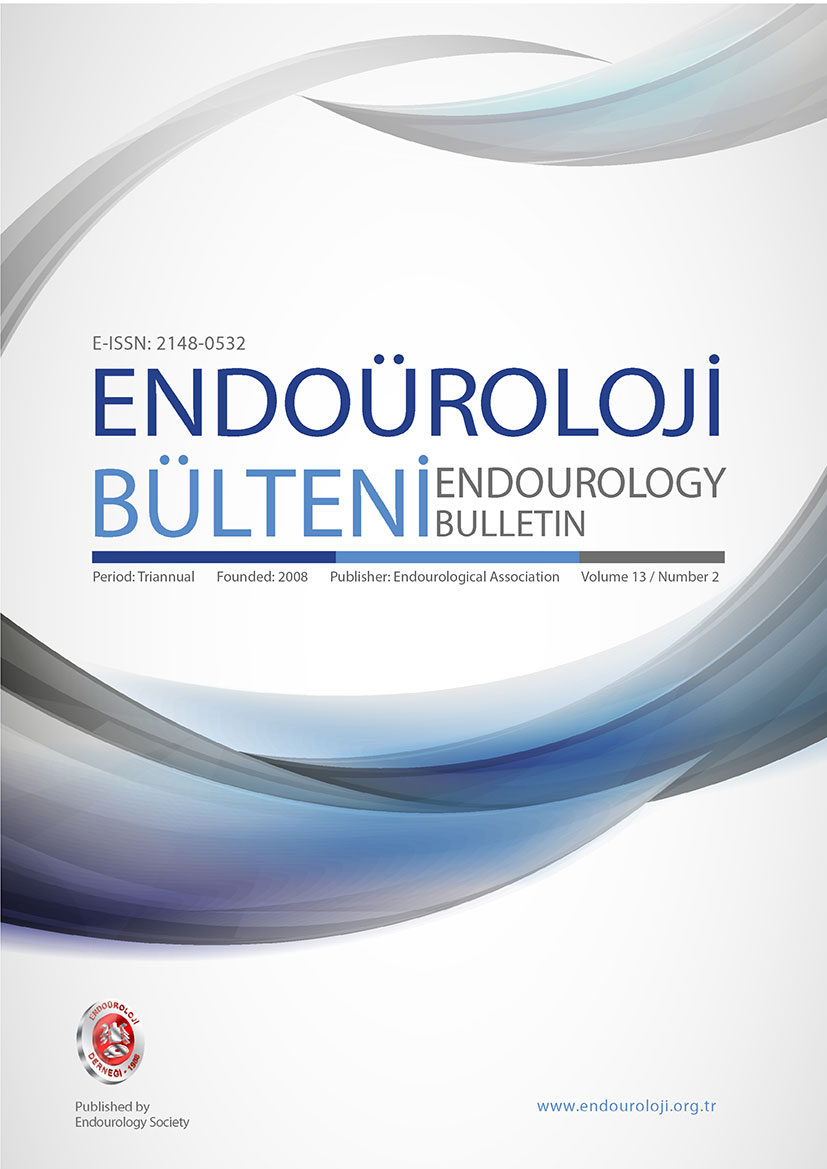
Editorial Board Message
Prof.Dr. R. Gökhan ATIŞ
Editorial Borad
Arbitrators List
Contents
Original Article
First experiences in laparoscopic donor nephrectomy after completion of a clinical fellowship program
Mehmet Altan, Anar Aghayev, Alihan Kokurcan, Sanem Çimen, Sertaç Çimen, Hasan Nedim Göksel Göktuğ
Abstracts
Objective: Kidney transplantation is the gold standard treatment method in patients with end-stage renal failure. The trend towards minimally invasive surgery in all areas of surgery has also manifested itself in kidney donor surgeries, and open donor nephrectomy has largely been replaced by laparoscopic donor nephrectomy. There are several ways to gain experience with laparoscopic donor nephrectomy. The first one is to receive an accredited kidney transplant minor branch education. In this study, we aimed to present the results of the first 12 cases performed by two surgeons who have received transplant surgery minor branch education abroad in a urology clinic that did not have previous kidney transplant and laparoscopic donor nephrectomy experience but advanced laparoscopic urological interventions.
Material And Methods: Laparoscopic donor nephrectomy cases performed between February 2017 and July 2019 were analyzed retrospectively. The database in which the preoperative, intraoperative and postoperative data of the patients were recorded was analyzed. All donor nephrectomy surgeries were performed with a pure laparoscopic transperitoneal approach.
Results: Six of the 12 patients (%50) who underwent laparoscopic donor nephrectomy were women and 6 (%50) were men. While the mean age of our patients was 45.0 ± 13.0 years, the age distribution ranged from 22 to 65, with the median being 49 years. In 11 out of 12 case (%91) for donor nephrectomy, the left kidney was preferred because the left renal vein and artery were longer than the right. The mean operation time of our patients was 96.0 ± 8.0 min and the mean warm ischemia time was 4.0 ± 2.0 min. The average length of hospital stay was 2.5 ± 0.5 days.
Conclusion: Laparoscopic donor nephrectomy should be performed by experienced or adequately trained
surgeons. In a urology clinic without previous laparoscopic donor nephrectomy experience, cases of laparoscopic donor nephrectomy performed with the relevant minor branch training can provide safe and
successful results in comparison with the literature.
Keywords: Donor, laparoscopy, nephrectomy, transplantation
Original Article
Oncologic and functional outcomes of open retropubic vs robot-assisted radical prostatectomy in patients with high risk prostate cancer
Furkan Sendogan, Volkan Tuğcu, Turgay Turan, Selçuk Şahin, Özgür Efiloğlu, Asıf Yıldırım
Abstract
Objective: The aim of this study is to evaluate oncological and functional outcomes of open radical prostatectomy (ORP) and robot-assisted prostatectomy (RARP) in patients with high-risk prostate cancer.
Material and Methods: In our study, patients with high-risk prostate cancer who underwent 118 ORP and 66 RARP between 2014-2018 have been evaluated retrospectively. Patients with prostate specific antigen (PSA)>20 ng/ml or Gleason score >7 or clinical stage ≥T2c according to D’Amico risk classifications are considered to high-risk prostate cancer. Preoperative abdominal magnetic resonance imaging (MRI) and bone scintigraphy were performed in each patient to assess the risk of extracapsular extension and exclude metastasis. The PSA value of 0.2 ng/mL in patients following two consecutive evaluations is accepted as biochemical recurrence. Urinary continence with pad use and erectile function were evaluated by verbal questioning of vaginal penetration performed with or without the use of phosphodiesterase type-5 inhibitors.
Results: In our study; preoperative PSA values, prostate biopsy ISUP grade, and clinical stage were found significantly higher in the ORP group. There was no significant difference between the groups in terms of positive surgical margin, extracapsular extension, seminal vesicle, and lymph node invasion. Biochemical recurrence was higher in the ORP group but there was no significant difference between the groups in terms of adjuvant treatments such as radiotherapy and androgen deprivation therapy. And there was no significant difference in urinary incontinence and erectile dysfunction in the first-year assessments of patients. Median follow-up was 15.55 and 46.45 months for RARP and ORP, respectively.
Conclusion: ORP and RARP have similar oncological and functional outcomes in high-risk prostate cancer.
Keywords: Robot-assisted radical prostatectomy, high risk prostate cancer, open retropubic radical prostatectomy
Original Article
Is the clinical significance of double-J stent colonization following ureteroscopic lithotripsy ignored?
Mehmet Çağlar Çakıcı, Ferhat Keser, Meftun Çulpan, Özgür Efiloğlu, Uygar Miçooğulları, Ahmet Tahra, Asıf Yıldırım
Abstract
Objective: To assess the significance of colonizing microorganisms in double-J stent (DJS) and determine the safest indwelling time of DJS that would cause no or less urinary tract infection (UTI) or colonization. Another objective was to examine the factors that influence DJS colonization.
Material And Methods: The data of patients that underwent ureteroscopic lithotripsy in our clinic from November 2017 till February 2020 were retrospectively reviewed and patients with DJS culture were included in the study. The patients were divided into two groups: DJS colonization positive (group 1) and DJS colonization negative (group 2).
Results: The colonization rate of 215 consecutive DJSs was 31.2%. Colonization increased with increasing age, especially in the 7th decade and later (p=0.013). The mean duration of DJS indwelling was 43.1±40.0 days in group 1 and 32.0 ± 15.6 days in group 2 (p=0.032). The colonization rates of DJS indwelling for 4 week or less, 4-6 weeks, and more than 6 weeks were 27.5%, 26.0% and 50.0%, respectively (p=0.017). DJS colonization positively correlated with development of UTI and urine culture positivity (kappa (κ) coefficient=0.100, κ=0.216, respectively, p<0,05). The multivariate regression analysis showed that the independent risk factors associated with UTI were urine culture positivity before stent removal (OR:29.487, p<0.001) and >6 weeks DJS indwelling time (OR:7.584, p=0.003).
Conclusion: Urine culture positivity and DJS indwelling longer than 6 weeks were the factors that could predict UTI in patients with DJS after ureteroscopic lithotripsy. In addition, high comorbidity score, UTI history and urine culture positivity were independent risk factors for DJS colonization.
Keywords: Colonization, double j stent, ureteroscopy, urine culture, urinary tract infection, urolithiasis.
Original Article
Comparison of three scoring system in the terms of stone-free status after Retrograde Intrarenal Surgery
Ahmet Tahra, Erdem Zengin, Resul Sobay, Eyüp Veli Küçük
Abstracts
Objective: Retrograde intrarenal surgery (RIRS) is safe and effective, minimally invasive method for renal stones however there is no accepted method for predicting stone-free rate after RIRS. We aimed to compare Resorlu-Unsal stone score, R.I.R.S scoring system, Modified Seoul National University Stone complexity (S-ReSC) scoring systems to evaluate the stone-free rates after flexible ureterorenoscopy (f-URS) for kidney Stones.
Material and Methods: Patients who underwent RIRC in 2018-2019 were evaluated retrospectively. Ninety-three patients who underwent postoperative Computerized Tomography (CT) to evaluate stone-free status were included in the study. Scoring was performed by the preoperative imaging of the patients. Stone-free status was defined as no fragment in postoperative CT. Factors affecting stone-free status were evaluated.
Results: The mean age was 45.07 ± 13.32 years. The mean stone size was 15.4 ± 4.31 mm. The stone-free rate was 82.8%. The median Resorlu-Unsal score was 0 (0-3), R.I.R.S score was 5 (4-10) and S-ReSC was 1 (1-12). Stone size and scoring systems were found to be significant in predicting stone-free in univariate analysis meanwhile only R.I.R.S. scoring system and S-ReSC scores were determined as predictive factors for stone-free in multivariate analysis (Table 1). In the ROC curve, all scoring systems had a high predictive ability in terms of stone-free rate.
Conclusion: All scoring systems are effective in determining the stone-free rate for f-URS. The predictability of S-ReSC and R.I.R.S. scoring systems were higher.
Keywords: Kidney stone, retrograde intrarenal surgery, scoring system
Original Article
Factors affecting infective complications after laser lithotripsy with flexible ureterorenoscopy in kidney stone treatment
Feyzullah Çelik, Şaban Oğuz Demirdöğen, Şenol Adanur
Abstract
Objective: We aimed to evaluate the factors affecting infectious complications after flexible ureterorenoscopy (f-URS) procedure with holmium laser in the treatment of kidney stones.
Material and Methods: 482 patients who underwent f-URS with holmium laser between January 2015 – October 2019 were analyzed retrospectively in terms of gender, age, comorbidity, history of endoscopic surgery in the last six months, urine analysis and urine culture, blood test, operation time, residual stones and stone size. All patients underwent a standard f-URS procedure. Postoperative infectious complications such as postoperative fever with urinary tract Infections, Systemic Inflammatory Response Syndrome (SIRS) and sepsis were evaluated.
Results: The mean age of the patients was 52±15 years and pre-oerative creatine levels were 0.94±0.34 mg/dL. Twenty-two patients undergoing the f-URS procedure had solitary kidneys. The number of patients with preoperative positive urine culture was 62 (12.9%) and 253 patients had a preoperative Double J (DJ) stent. The mean stone density was found 1010 ± 393 Hounsfield Unit (HU). Urethral access sheat was used in 473 patients during the operation. It was determined that the mean operation time was 56 ± 19 minutes. In the first session, the stone-free rate was found 80.7%. The incidence of infectious complications after f-URS was 10% (n = 48) of these patients (4.4%), SIRS in 11 (2.2%), and sepsis in 16 (3.4%). Univariate analysis result revealed that surgery time, high creatinine levels, preoperative positive urine culture, endoscopic stone treatment history in the last six months, presence of preoperative DJ stent, increase in stone size and residual stone were associated with postoperative complications (p <0.05). In the evaluation made with multivariate regression analysis, the duration of operation, preop positive urine culture and endoscopic stone treatment history in the last six months were found to be predictive factors for infectious complications after f-URS.
Conclusion: We observed that the duration of surgery, preoperative positive urine culture, and the history of endoscopic stone therapy in the last 6 months were independently associated with the development of infectious complications following the f-URS procedure.
Keywords: Kidney stones, flexible ureterorenoscopy, infective complications, risk factors
Original Article
Effect of the coronavirus pandemic on laparoscopic urological surgery
Alihan Kokurcan, Mehmet Çağlar Çakıcı, Ferhat Keser, Uygar Miçooğulları, Mehmet Altan, Erdem Kısa, Ahmet Nihat Karakoyunlu, Ramazan Gökhan Atış, Asıf Yıldırım
Abstract
Objective: Coronavirus disease (COVID-19) has affected all medical specialties including urology all over
the world. During the pandemic period, there has been decrease in the number of general outpatient and
urological surgeries. In this study, we aimed to evaluate the effects of the COVID-19 pandemic on laparoscopic urological surgery.
Material and Methods: The study was designed in Urology clinics in 3 high-volume centers, which are tertiary healthcare institutions. Patients who underwent laparoscopic surgery for 1 year between March 2020 and March 2021 during the pandemic period (Group-1) and patients who underwent laparoscopic surgery for 1 year before the pandemic (Group-2) and their complications were evaluated. This study designed as cross-sectional study and patient data were analyzed retrospectively using patient files.
Results: Of the 241 patients, 152 were in Group 1 and 89 were in Group 2. There was no difference between the groups in terms of gender and age. There was no significant difference between the groups in intraoperative and postoperative major complications (p=0.602; p=0.626). The number of urooncological surgeries performed in pandemic period (n=63; 70.8%) was significantly higher than pre-pandemic period (n=81; 53.3%) (p<0.05). Conclusion: As the effect of the pandemic, a significant decrease was observed in laparoscopic surgeries; however, a significant increase was observed in urooncologic surgery rates. When the complication rates were evaluated, there was no difference between the pandemic period and the pre-pandemic period.
Keywords: COVID-19, complication, laparoscopy, urooncology


